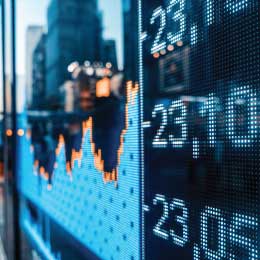
US stocks bear the brunt of global economic uncertainty
he global economic outlook is uncertain, yet European, UK, Chinese, and Japanese stocks all rose last week while US stocks fell.
The team manages USD 6 billion across its global platform, including USD 2.5 billion in emerging market local currency strategies.
Managing emerging market debt portfolios.
We cover more than 80 countries and integrate ESG into the investment processes of each of our strategies.
Emerging market debt is the fixed income debt that is issued by countries with developing economies as well as by corporations within those nations. It includes local and hard currency. Since countries can be at different stages in the economic cycle, interest rates and returns can be uncorrelated to those in developed markets.
We cover more than 80 countries and integrate ESG into the investment processes of each of our strategies, using a qualitative and quantitative framework. We don’t view markets or regions in isolation, instead we use a top-down global macro analysis to see how developed and EM economies are linked to help identify risks for a portfolio. By investing in emerging market debt our clients can benefit from diversification in their fixed income strategy and yield enhancement.
Drawing on Invesco’s comprehensive suite of expertise, we offer a monthly outlook piece. Covering market commentary, country insights and macroeconomic insights.

We believe that the integration of ESG into sovereign investing needs to incorporate an assessment of a government’s policy intentions. We make efforts to integrate ESG factors at all steps of the investment process and portfolio construction. We believe countries with good government quality and a strong pro-investment policy mindset are inherently beneficial to long-term sustainability. This has an enduring positive environmental and social impact on the wellbeing of these country’s citizens.



Let us know your preferences to receive insights and ideas on the themes and strategies of most interest to you.

US stocks bear the brunt of global economic uncertainty
he global economic outlook is uncertain, yet European, UK, Chinese, and Japanese stocks all rose last week while US stocks fell.

Asset allocation opportunities and market strategy
In our quarterly analysis, Invesco experts track major trends and structural issues that investors may want to consider when making asset allocation decisions. Read our latest analysis that covers market strategy and opportunities across various asset classes.

Treasuries, sentiment, and earnings: What investors need to watch
Six things for investors to watch in the coming weeks, including US Treasury yields, US and European sentiment, US earnings guidance, and Chinese economic data.

What could prevent a further collapse in US stocks?
Welcome to Uncommon Truths, Paul Jackson and Andras Vig’s regular in-depth look at the big topics impacting markets.

Capital market assumptions | Q1 2025
Invesco Solutions develops capital market assumptions (CMAs) that provide long-term estimates for the behaviour of major asset classes globally.
Emerging market debt is the fixed income debt that is issued by countries with developing economies as well as by corporations within those nations. It includes local and hard currency.
Broad fixed income markets have declined in 2022. Emerging market (EM) debt has suffered one of its largest selloffs since the 1990s, even though bottom-up fundamentals are relatively sound. However, we believe the emerging market offers a long-term optimistic outlook for investors.
Local currency bonds are debt securities issued by sovereigns or corporates in their local currency. The return drivers come from local yields, capital appreciation (changes in yield curve or credit standing) and FX. Since countries can be at different stages in the economic cycle, interest rates and returns can be uncorrelated to those in developed markets. Given continued growth, local currency bonds tend to be more liquid than hard currency bonds and the list of markets with investible/liquid local bond markets that are accessible to foreign investors, continues to increase.
Hard currency bonds are debt securities issued by sovereigns or corporates in other currencies – usually in a developed market currency, such as the USD or euro. Many low income, weaker developing countries, “frontier markets” are incented to issue in hard currency to attract foreign investment (perceived as less risky if issued as a USD or euro asset) versus issuing in their local currency.
You can invest in emerging market debt by either investing in actively managed mutual funds or exchange traded funds (ETFs). Invesco offers a broad range of actively managed funds and ETFs.
The integration of ESG into investment practice is rapidly evolving for fixed income investors. There is growing regulatory interest and market demand for sustainable investments. In addition to a growing preference for some investors.
The return drivers come from local yields, capital appreciation (changes in yield curve or credit standing) and forex (FX).
For complete information on risks, refer to the legal documents.
The value of investments and any income will fluctuate (this may partly be the result of exchange-rate fluctuations) and investors may not get back the full amount invested.
As a large portion of the strategy is invested in less developed countries, you should be prepared to accept significantly large fluctuations in value.
The strategy will invest in derivatives (complex instruments) which will result in leverage and may result in large fluctuations in value.
Debt instruments are exposed to credit risk which is the ability of the borrower to repay the interest and capital on the redemption date.
Investments in debt instruments which are of lower credit quality may result in large fluctuations in value.
Changes in interest rates will result in fluctuations in value.
The strategy may invest in distressed securities which carry a significant risk of capital loss.
Investment in certain securities listed in China can involve significant regulatory constraints that may affect liquidity and/or investment performance.
Data as at July 29 2024, unless otherwise stated. This is marketing material and not intended as a recommendation to buy or sell any particular asset class, security or strategy. Regulatory requirements that require impartiality of investment/investment strategy recommendations are therefore not applicable nor are any prohibitions to trade before publication.
Where individuals or the business have expressed opinions, they are based on current market conditions, they may differ from those of other investment professionals and are subject to change without notice.
EMEA3746646